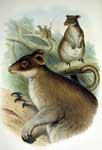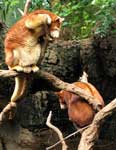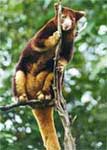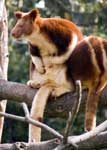Cladus: Eukaryota
Name Dendrolagus Müller, 1840 Type species: D. ursinus Müller, 1840 References * Dendrolagus on Mammal Species of the World. Vernacular names Tree-kangaroos are macropods adapted for life in trees. They are found in the rainforests of New Guinea, far northeastern Queensland, and nearby islands. Although most are found in mountainous areas, several species also occur in lowlands, such as the aptly named Lowlands Tree-kangaroo. Most tree-kangaroos are considered threatened due to hunting and habitat loss. There are approximately 12 species of tree-kangaroos, though some uncertainty exists due to taxonomy. Depending on species, there are significant variations in the colour of the pelage and size, with a head and body length of 41 to 77 centimetres (16 to 30 in), a tail length of 40 to 87 centimetres (16 to 34 in), and a weight of up to 14.5 kilograms (32 lb). Females are smaller than males.
It is understood that tree-kangaroos evolved from creatures similar to modern kangaroos and wallabies, as they retain many standard macropod adaptations to life in the plains—notably the massive hind legs and long, narrow feet which allow orthodox macropods to travel quickly and economically on the ground. Tree-kangaroos have developed exceptionally long tails for balance, and stronger forelimbs for climbing. The feet are shorter and wider, they have longer claws on all feet, and rubbery soles for better grip. The ancestors of all kangaroos are believed to have been small arboreal marsupials that looked like some of Australia's present-day possums. The earliest macropods diverged from this line when they descended to the ground and evolved bodies adapted for rapid motion over the earth and rocks. Why the ancestors of the tree-kangaroos returned to the trees is not known, but it is believed to have happened due to a lack of open ground in their modern habitat. Thus, those who were able to live in trees were naturally selected to survive. Locomotion
Diet Tree-kangaroos feed mostly on leaves and fruit, taken both in trees and on the ground, but other foods are eaten when available, including grain, flowers, sap, bark, eggs and young birds. Their teeth are adapted for tearing leaves rather than cutting grass. They have large stomachs that function as fermentation vats in a manner similar to those of eutherian ruminant herbivores, in which bacteria break down fibrous leaves and grasses. Although the arrangement of the stomach compartments in kangaroos is quite different than eutherian ruminants, the end result is similar. Species The following species are assigned to the genus Dendrolagus:[1] * Grizzled Tree-kangaroo, Dendrolagus inustus; northern and western New Guinea, plus the island of Yapen, and possibly Salawati and Waigeo. Lumholtz's Tree-kangaroo The taxonomy, especially of the Dendrolagus dorianus and Dendrolagus goodfellowi superspecies, is complex. The taxon stellarum was described as a subspecies of the D. dorianus,[2][3] but some recent authorities have treated it as a species based on its absolute diagnostability.[1] It has further been suggested that the taxon mayri, known only from a single old specimen, may represent a valid species,[4] but as it is virtually unknown, most authorities have retained it as a subspecies of D. dorianus.[1] The case for pulcherrimus is comparable to that of stellarum. It was initially described as a subspecies of Dendrolagus goodfellowi,[2] but recent authorities have elevated it to species status based on its absolute diagnostability.[1] A population of the Tenkile recently discovered from the Bewani Mountains may represent an undescribed subspecies.[5] References 1. ^ a b c d e Groves, C. (2005). Wilson, D. E., & Reeder, D. M, eds. ed. Mammal Species of the World (3rd ed.). Baltimore: Johns Hopkins University Press. pp. 59-61. ISBN 0-801-88221-4. OCLC 62265494. http://www.bucknell.edu/msw3. * Flannery, Timothy Fridtjof, et al. 1996. Tree Kangaroos: A Curious Natural History. Reed Books, Melbourne. ISBN 0-7301-0492-3 Source: Wikipedia, Wikispecies: All text is available under the terms of the GNU Free Documentation License |
|






